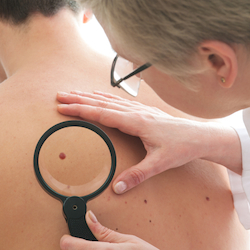Introduction
Showing men a video on skin self-examination and skin awareness may help to increase the number of patients who receive whole-body clinical skin examinations (CSEs) from their physicians, which could increase skin cancer diagnosis in older men, according to a study by Monika Janda, Ph.D., of the Queensland University of Technology, Brisbane, Australia, and colleagues. Links: Patient Video posted on YouTube and from the digital library at the the Queensland University of Techology. DVDs are available on request from the study authors, link here to contact the author.
 In the United States, death rates from melanoma have decreased in women but have increased in men. Early detection is an important strategy and can be done with clinical or skin self-examination, according to the study background.
In the United States, death rates from melanoma have decreased in women but have increased in men. Early detection is an important strategy and can be done with clinical or skin self-examination, according to the study background.
The researchers randomized 930 men (age 50 and older) to receive either a skin awareness video-based intervention and brochures or brochures only (control group). Outcome measures were those patients who reported a CSE, what type (skin spot, partial body or whole body), who initiated it, whether the physician noted any suspicious lesions and how the lesions were managed.
After seven months, 62.1 percent reported a CSE after receiving the intervention materials. CSEs had a comparable proportion of men in between the intervention and control groups, but men in the intervention were more likely to report a whole-body CSE. A higher proportion of malignant lesions were diagnosed in the video intervention group.
Overall, 540 of 870 men (62.1%) self-reported a CSE since receiving intervention materials, and 321 of 540 (59.4%) consented for their physician to provide medical information (received for 266 of 321 [82.9%]). Attendance of any CSE was similar between groups (intervention group, 246 of 436 [56.4%]; control group, 229 of 434 [52.8%]), but men in the intervention group were more likely to self-report a whole-body CSE (154 of 436 [35.3%] vs 118 of 434 [27.2%] for control group; P = .01). Two melanomas, 29 squamous cell carcinomas, and 38 basal cell carcinomas were diagnosed, with a higher proportion of malignant lesions in the intervention group (60.0% vs 40.0% for controls; P = .03). Baseline attitudes, behaviors, and skin cancer history were associated with higher odds of CSE and skin cancer diagnosis.
“We acknowledge that routine use of CSE as a screening tool will place a burden on the health care system and could lead to the detection of skin cancers that are relatively indolent and may never cause death or significant morbidity,” the authors conclude. “However, with increasing evidence from observational studies supporting the effects of CSE in reducing the incidence of thick melanomas and melanoma-associated mortality rates and with evidence of potential reductions in the cost-benefit ratio, our results support implementing behavioral interventions to encourage skin awareness among men aged at least 50 years.”
Source: JAMA Dermatology. Published online February 19, 2014.




